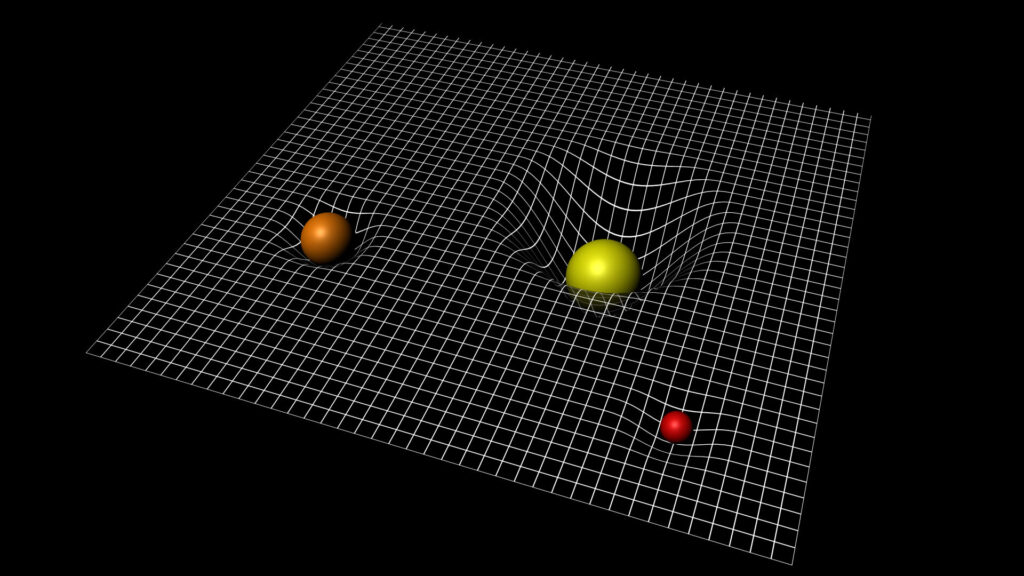
Illustration of spacetime curvature, showing that more massive objects bend the fabric of space and time more than objects with less mass. Physicists define mass as “resistance,” not weight. Image: European Space Agency
By Mariana Meneses and James Myers
A complete description of gravity has long eluded scientists because gravity’s interactions are very weak, compared to interactions of the three other fundamental forces of physics, making gravity extremely difficult to test.
However, researchers from the Universities of Amsterdam and Ulm recently proposed a novel experiment that could help determine whether gravity is inherently a product of classical physics or one of quantum mechanics. The experiment is designed to look “more closely at the whole dynamics induced by gravity on a quantum system.”
If a means to carry out the experiment can be devised, the result might address the dilemma described in 2014 by Sir Roger Penrose, “that the case for ‘gravitizing’ quantum theory is at least as strong as that for quantizing gravity.” Penrose’s dilemma could also extend to the source of gravity of black holes, which are at the center of practically all galaxies and exert the most intense gravity in the universe. Penrose was awarded the 2020 Nobel Prize in Physics “for the discovery that black hole formation is a robust prediction of the [Einstein’s] general theory of relativity.”
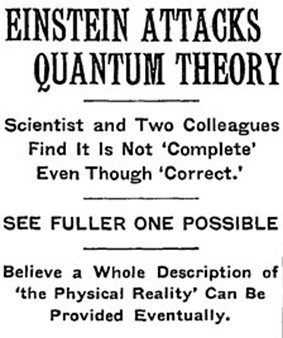
Headline in the May 4, 1935 edition of The New York Times, on the the now famous paper by Einstein, Podolsky, and Rosen (the latter was the primary author) arguing that quantum mechanics should obey “elements of reality” and proposing that quantum mechanics could be subject to hidden variables. Experiments to date have not found any hidden variables, and “The fact that quantum mechanics violates Bell inequalities indicates that any hidden-variable theory underlying quantum mechanics must be non-local; whether this should be taken to imply that quantum mechanics itself is non-local is a matter of continuing debate.” Image and quote: Wikipedia
Previous proposals aimed primarily at detecting whether gravity could induce quantum entanglement, since if that were the case it would provide proof that gravity arises from quantum mechanical interactions. No practical means of testing these proposals have yet been devised, principally as a result of the difficulty of maintaining quantum entangled states long enough for testing.
Creating and maintaining entangled states of large objects requires them to be in highly “delocalized” quantum states, meaning their wave functions of probabilities are spread out over a large volume of space. This is extremely challenging because it demands precise control and isolation from environmental disturbances which can easily disrupt the delicate entangled states, making them difficult to create and even harder to detect.
The new experiment has devised a novel approach for testing the priority of either quantum entanglement or general relativity as gravity’s source, and it could help to resolve Penrose’s dilemma.
Quantum entanglement is a fundamental phenomenon in quantum mechanics where two or more particles become connected such that the state of one particle cannot be described independently of the state of the other(s), regardless of the distance separating them. This unique correlation, which has been tested many times and was the subject of the 2022 Nobel Prize in Physics, means that the measurement of one entangled particle’s state instantly determines the state of the other without the passage of time.
What did Einstein mean by “Spooky Action at a Distance”? | Sabine Hossenfelder
Entanglement arises from interactions between quantum particles and is preserved even when the particles are separated by great distances.
It defies classical intuitions of locality, realism, and time, and Einstein expressed his reservations against the idea when he called it “spooky action at a distance.” Einstein’s view was that gravity is the result of the geometry of spacetime, which bends or stretches in response to varying amounts of resistance (resistance, not weight, is how physicists define mass).
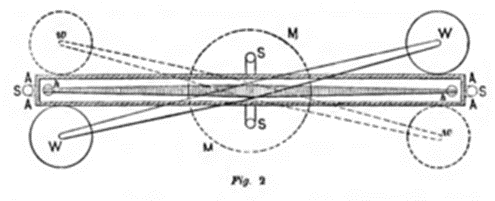
Diagram by Henry Cavendish of the torsion pendulum, seen from above, that was used in his 1797-1798 experiment to measure the force of gravity, the first such experiment to be conducted in a laboratory and the first to produce an accurate measurement of Earth’s mass. The researchers propose to employ a torsion pendulum much like the one that Cavendish used. Image: Wikipedia .
The new experimental approach, which involves using harmonic oscillators like torsion pendula, could reveal the quantum nature of gravity through measurable signals that a classical gravitational field shouldn’t produce. The study was led by Dr. Ludovico Lami.
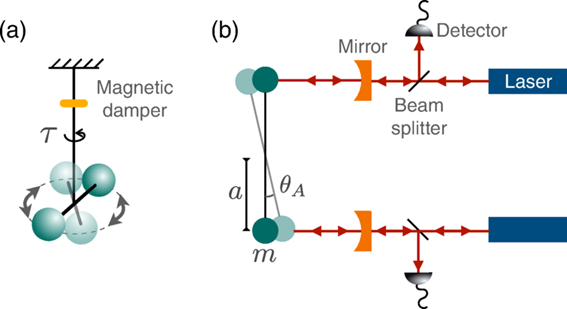
FIG. 6. from the research abstract. Optomechanical torsion balance. Panel (a) shows a sketch of a torsion pendulum with a dumbbell-shaped body suspended from a thin wire with torsion constant 𝜏. A magnetic damper attached to the wire damps mechanical modes other than the torsional one. Panel (b) presents a scheme of the optomechanical system composed of the torsion pendulum and two optical cavities. The light output of each cavity is a measure of the position of the corresponding edge of the pendulum. Independent measurements of the position of each end of the pendulum can be added or subtracted to discriminate between purely rotational motion and pendular swinging.”
The experiment involves two small pendula, each weighing less than a gram, oscillating near each other with their mutual gravitational attraction being the dominant force. By carefully monitoring their oscillations with laser light, researchers can detect subtle changes in their states. If the pendula behave in ways predicted by quantum gravity, it will indicate that gravity is not a consequence of classical general relativity.
This method avoids the complexities of creating highly delocalized quantum states and detecting fragile entanglements. It is a promising alternative, if a technology can be developed to maintain the pendula in a required ground-state of cooling to eliminate interference from environmental sources like heat. The researchers state that such cooling should, in principle, be possible.
If successful, the new approach could help to reconcile gravity with the quantum description of other fundamental forces, significantly advancing our understanding of the universe.
Modern physics stands on two foundational pillars: quantum physics and Einstein’s theory of general relativity.
Despite their success, the relationship between these theories remains elusive, and is driving further research into quantum gravity.
Quantum gravity is a field in physics that seeks to unify general relativity, which explains gravitational phenomena on large scales, and quantum mechanics, which governs the behavior of particles on atomic and subatomic scales.
Classical mechanics breaks down at light speed or in strong gravitational fields such as those surrounding black holes, while quantum mechanics struggles to incorporate gravitational interactions. The results lead to mathematical inconsistencies like infinities and divisions by zero. Singularities, such as those in black holes or at the Big Bang, exemplify regions where both theories break down.
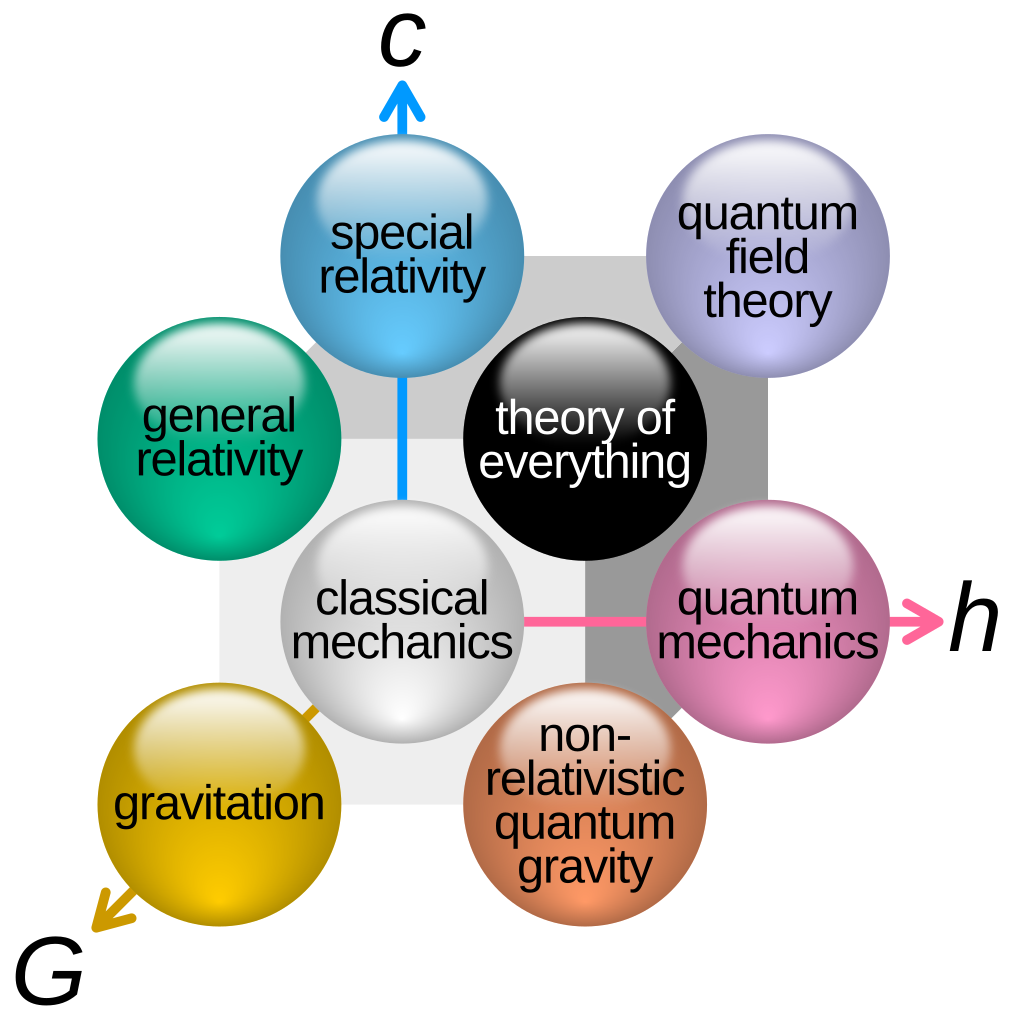
“cGh physics refers to the historical attempts in physics to unify relativity, gravitation, and quantum mechanics” ( Wikipedia ). Image: Cmglee .
Theories proposed to address quantum gravity include string theory, which conceptualizes particles as one-dimensional strings vibrating at specific frequencies and suggests six or more extra dimensions beyond the four that we perceive.
Another approach is loop quantum gravity, which quantizes spacetime itself into discrete loops, avoiding the need for extra dimensions although it faces criticism for potentially oversimplifying quantum mechanical properties.
The holographic principle offers a different perspective, suggesting that all information within a volume of space can be represented on its boundary, potentially resolving gravitational problems by reducing dimensions.
Despite these theoretical advancements, for now, at least, these ideas remain in the hypothetical realm.
The pursuit of a unified theory of quantum gravity could revolutionize our understanding of the universe, similar to the ways that discoveries of electromagnetism and radioactivity transformed technology and medicine. This ongoing research underscores the importance of fundamental scientific inquiry and its potential to yield groundbreaking discoveries.
Recent advances, particularly in string theory and quantum field theory, have led to significant insights in the concept of holography, which connects higher-dimensional quantum gravity with lower-dimensional field theories.
Notably, holographic methods have revealed crucial roles for quantum entanglement and computational complexity in shaping spacetime, advancing our grasp of phenomena from the quark-gluon plasma to the behavior of strange metals and even the potential resolution of the black hole information paradox.
The experiment proposed by Dr. Lami and co-authors marks a significant step forward in the quest to understand gravity at the level of the quantum.
By employing torsion pendula and bypassing the challenges of creating and maintaining entangled quantum states, this method holds the potential to bridge the gap between quantum mechanics and general relativity. If successful, it could potentially revolutionize our understanding of the fundamental forces of the physical universe.
Craving more information? Check out these recommended TQR articles:
- Race for Post-Quantum Cryptography: Will Proposed Encryption Standards Secure the World’s Data?
- What Will a Recent Quantum Leap in Time Crystal Technology Reveal About the Elusive Nature of Time?
- Breakthrough in Error Correction Opens Potential for Large-Scale Quantum Computer Processing
- The Future of Quantum Computing Accelerates, Many Qubits at a Time
- The Incredible Power of Shape: Fractals Connect Quantum Computers to the Human Body and the Cosmos




Am always interested in astronomy and new ideas 💡🤗
There is no beginning or ending if time does not exist,this only applies to the Singularity,for everyone else time does exist.sgrA* is not the singularity because every galaxy has one so if sgrA* is a million times bigger than our sun then the real OLD is a millions times bigger than sgrA*. The singularity is just that,a singularity,a region where only pure thought exists, sgrA* is merely one child of many that were born to the OLD.